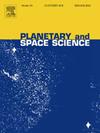67P彗星的耐火冰比:对原行星盘彗星形成区域组成的启示
IF 1.7
4区 物理与天体物理
Q3 ASTRONOMY & ASTROPHYSICS
引用次数: 0
摘要
彗星、小行星和其他小天体被认为是太阳系原始微行星种群的残余。因此,它们的物理、化学和同位素特性掌握了它们如何形成、在哪里形成以及如何演化的关键细节。然而,对这些天体的形成区域进行精确限制一直是一项挑战。来自航天器任务的数据在解决被访问天体的起源问题方面具有特别大的潜力。欧洲航天局的罗塞塔号探测器向67P/丘留莫夫-格拉西门科彗星返回了这颗彗星在绕太阳飞行两年中传回的数据。这个广泛的数据集彻底改变了我们对彗星的看法,但仍然存在未解决的问题。在这里,我们的目标是根据罗塞塔数据确定67P彗星的总体元素组成,包括它的耐火材料与冰的比例。我们利用这些结果来限制彗星形成的原行星盘中的温度,并使用圆盘模型来确定形成位置。我们使用Rosetta/ROSINA(用于离子和中性分析的Rosetta轨道器光谱仪)测量了67P彗星的挥发性/冰成分,Rosetta/COSIMA(彗星次级离子质量分析仪)测量了67P彗星的难熔成分。这些测量是用蒙特卡罗方法组合起来的。耐火材料与冰的比是一个自由参数,它是后验约束的。仅使用组成,我们将耐火材料与冰的比值限制为0.5<χ<1.7,并推导出67P中H、C、N、O、Na、Mg、Al、S、K、Ar、Ca、Cr、Mn、Fe、Kr和Xe的总体元素丰度。我们在67P彗星上发现稀有气体氙的元素丰度接近太阳。氪略微耗尽,而氩则严重耗尽。与CI球粒陨石相比,67P彗星富含这三种稀有气体,含量高达2.5个数量级。我们表明,这与原行星盘区域中温度在30至40 K之间的25至35 au之间的形成区域以及原行星盘环中长时间捕获尘埃是一致的。本文章由计算机程序翻译,如有差异,请以英文原文为准。
The refractory-to-ice ratio in comet 67P: Implications on the composition of the comet-forming region of the protoplanetary disk
Comets, asteroids, and other small bodies are thought to be remnants of the original planetesimal population of the Solar System. As such, their physical, chemical, and isotopic properties hold crucial details on how and where they formed and how they evolved. Yet, placing precise constraints on the formation region of these bodies has been challenging. Data from spacecraft missions have a particularly high potential of addressing the question of the origin of the visited bodies. ESA’s Rosetta mission to comet 67P/Churyumov-Gerasimenko returned data from the comet for two years on its journey around the Sun. This extensive data set has revolutionized our view on comets and still holds unsolved problems.
Here, we aim to determine comet 67P’s bulk elemental composition from Rosetta data, including its refractory-to-ice ratio. We use these results to constrain the temperature in the protoplanetary disk where comets formed and, using a disk model, the formation location.
We use the Rosetta/ROSINA (Rosetta Orbiter Spectrometer for Ion and Neutral Analysis) measurement of the volatile/ice composition and the Rosetta/COSIMA (COmetary Secondary Ion Mass Analyzer) measurements of the refractory composition of comet 67P. These measurements are combined using a Monte Carlo method. The refractory-to-ice ratio is a free parameter that is constrained a posteriori.
Using only the composition, we constrain the refractory-to-ice ratio to , and derive the bulk elemental abundances for 67P of H, C, N, O, Na, Mg, Al, S, K, Ar, Ca, Cr, Mn, Fe, Kr, and Xe. We find the noble gas xenon in near solar elemental abundance in comet 67P. Krypton is slightly depleted, while argon is heavily depleted. Comet 67P is enriched in all three noble gases by up to 2.5 orders of magnitude compared to CI chondrites. We show this is consistent with a formation region between 25 and 35 au in a protoplanetary disk region with temperatures between 30 and 40 K and with the trapping of dust for a long time in rings of the protoplanetary disk.
求助全文
通过发布文献求助,成功后即可免费获取论文全文。
去求助
来源期刊

Planetary and Space Science
地学天文-天文与天体物理
CiteScore
5.40
自引率
4.20%
发文量
126
审稿时长
15 weeks
期刊介绍:
Planetary and Space Science publishes original articles as well as short communications (letters). Ground-based and space-borne instrumentation and laboratory simulation of solar system processes are included. The following fields of planetary and solar system research are covered:
• Celestial mechanics, including dynamical evolution of the solar system, gravitational captures and resonances, relativistic effects, tracking and dynamics
• Cosmochemistry and origin, including all aspects of the formation and initial physical and chemical evolution of the solar system
• Terrestrial planets and satellites, including the physics of the interiors, geology and morphology of the surfaces, tectonics, mineralogy and dating
• Outer planets and satellites, including formation and evolution, remote sensing at all wavelengths and in situ measurements
• Planetary atmospheres, including formation and evolution, circulation and meteorology, boundary layers, remote sensing and laboratory simulation
• Planetary magnetospheres and ionospheres, including origin of magnetic fields, magnetospheric plasma and radiation belts, and their interaction with the sun, the solar wind and satellites
• Small bodies, dust and rings, including asteroids, comets and zodiacal light and their interaction with the solar radiation and the solar wind
• Exobiology, including origin of life, detection of planetary ecosystems and pre-biological phenomena in the solar system and laboratory simulations
• Extrasolar systems, including the detection and/or the detectability of exoplanets and planetary systems, their formation and evolution, the physical and chemical properties of the exoplanets
• History of planetary and space research
 求助内容:
求助内容: 应助结果提醒方式:
应助结果提醒方式:


